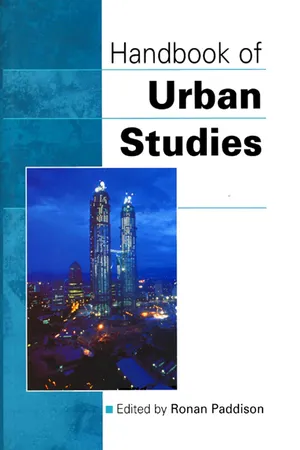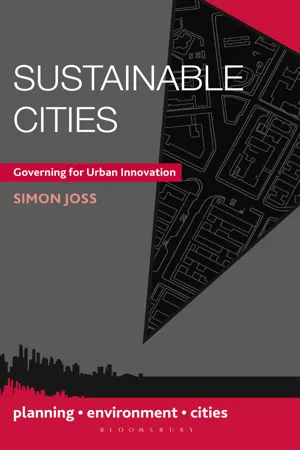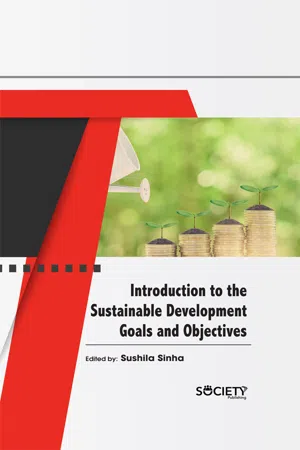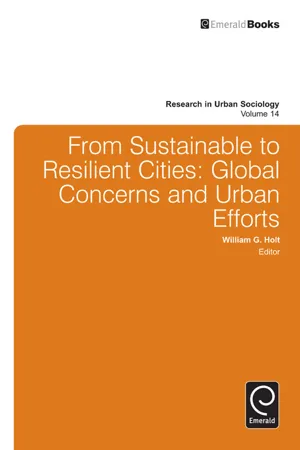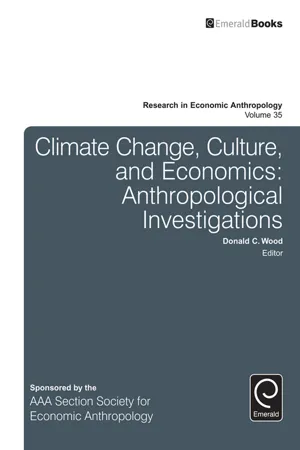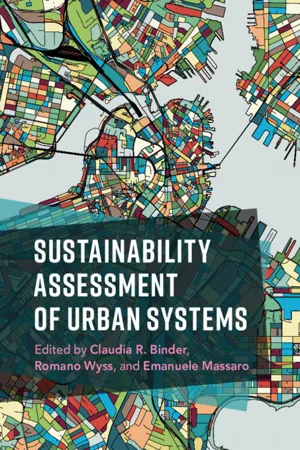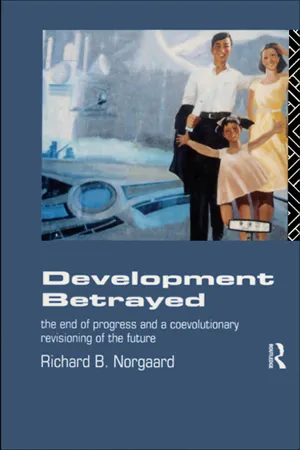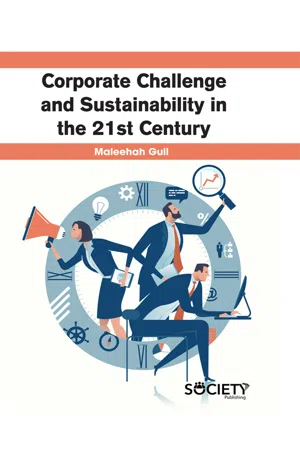Geography
Challenges to Urban Sustainability
Challenges to urban sustainability refer to the obstacles and issues that cities face in maintaining a balance between economic, social, and environmental well-being. These challenges can include overpopulation, inadequate infrastructure, pollution, and resource depletion. Addressing these challenges requires integrated planning, efficient resource management, and the promotion of sustainable practices to ensure the long-term viability of urban areas.
Written by Perlego with AI-assistance
Related key terms
1 of 5
10 Key excerpts on "Challenges to Urban Sustainability"
- Stephen A. Roosa(Author)
- 2020(Publication Date)
- River Publishers(Publisher)
Effects include adverse environmental im-pacts, dislocation of populations, and changes in urban infrastructure. The broad issues concerning cities and the manner in which their policies di-rectly and indirectly impact urban energy use will be explored. 1 2 Sustainable Development Handbook Sustainable development is a theoretical construct. After all, sustain-ability within the time frame of the human experience on Earth, may be difficult if not impossible to achieve. Therefore, using the concept of sus-tainability as a catch-all solution for all global problems is fraught with peril. According to Harken (1993:211), “Most global problems cannot be solved globally because they are global symptoms of local problems with roots in reductionist thinking that goes back to the scientific revolution and the beginnings of industrialism.” This reality does nothing to diminish the importance of sustainable development. Many aspects of the concept of sustainability have problem-solving implications for industry, institutions, corporations, and govern-ments. Most often, sustainability becomes defined more by the policies that are deployed and the agendas that these policies establish. To compli-cate the difficulties in implementing the agenda, understand that sustain-ability has far-reaching and universal implications. Sustainability is about resources, management policies, energy, social concerns, planning, eco-nomics, environmental impacts, construction practices, and much more. Responding to its agenda has caused institutions to rethink basic process-es, with the potential of yielding fresh and creative solutions to current problems. Understanding sustainability is a complex task. Berke believes that sustainability may be the next paradigm or “framework to dramatically shift the practice of local participation from dominance by narrow spe-cial interests toward a more holistic and inclusive view” (Berke 2002:23).- eBook - PDF
- Ronan Paddison(Author)
- 2000(Publication Date)
- SAGE Publications Ltd(Publisher)
All this has far-reaching consequences for urban science and environmental planning. In a condition of relative demographic and economic equilibrium between city and countryside, the destiny of cities depends heavily upon the quality of their own physical lay-out, internal functioning and equilibrium between the built and the natural environment. In a condition of imbalance, on the contrary, their destiny depends upon the develop-ment process that is happening outside them; any policy intervention on urban assets is destined to amplify the perceived disparity in the develop-ment potential between the city and the 136 Handbook of Urban Studies countryside, fostering cumulative immigration processes that annihilate the potential effects of the initial intervention (Lo, 1992). Consequently, in developing countries, policies addressed to the sustainable development of big cities should be complemented in parallel by: • policies focused on a balanced regional devel-opment, and in particular policies for the development of rural areas; • policies focused on the construction of a balanced urban system, based on a creative, country-specific blending of the traditional hierarchical pattern of centres and the modern network pattern of specialized centres (Camagni, 1992; Camagni, 1994). 8.7. URBAN SUSTAINABILITY PRINCIPLES AND POLICY IMPLICATIONS As mentioned above, the strict application of urban sustainability requires a focus on the economic, social and environmental aspects of urban life (cf. Newman and Thornley, 1994). This calls usually also for a strict urban energy conservation policy (see Banister, 1996b; Newman and Kenworthy, 1989, 1991). In many cases, targets and critical limits for various aspects (indicators) of urban sustainability have to be specified (for example, noise level, CO 2 levels, density, traffic etc.). - eBook - PDF
Sustainable Cities
Governing for Urban Innovation
- Simon Joss(Author)
- 2017(Publication Date)
- Red Globe Press(Publisher)
Furthermore, these dimensions are not presented atom-istically; they are understood as interlaced and layered over each other: concerns about cities’ environmental impacts at wider regional and global levels are typically woven into concerns about local-level environmental impacts. Similarly, structural connections are made between social and economic sustainability issues and environmental issues. A focus on intervention at the neighbourhood level meshes with a focus on city-wide and city-regional interven-tion. Interest in technological innovations may be framed in terms of a broader interest in social innovations. And interest in institutional governance is interlaced with interest in wider civic governance. As noted, the challenge of defining the sustainable city is in bring-ing these diverse principles together in a coherent way, as well as translating them into viable practices. Despite the open-ended nature of this challenge, however, certain commonalities can be observed across many initiatives. By way of illustration, three contemporary ‘theming’ tendencies in the organization of sustain-ability principles are outlined below, each privileging a different set of perspectives and goals. Contemporary theme 1: the low-carbon eco-city Faced with the diverse – and at times contrasting – dimensions of the sustainable city, one could be forgiven for feeling rather puzzled about what forms its core. One perspective places environmental concern centre stage. Some would say that it is mainly and most urgently about greenhouse gas emissions and energy use (see Box 1.3). Certainly, the recent rise of the sustainable city to key policy proposition globally has coincided with international debate about global warming and climate change. One of the reasons why cities are identified as the ‘front line’, or ‘battleground’, for action against climate change is that they are Sustainability and the City? 23 responsible for a large share of the GHG emissions produced. - Sushila Sinha(Author)
- 2020(Publication Date)
- Society Publishing(Publisher)
Global Challenges of Sustainable Development 7 CONTENTS 7.1. Introduction .................................................................................... 170 7.2. Challenges Of Sustainable Development ........................................ 172 7.3. Environmental Challenges To Sustainable Development Climate Change ........................................................................... 179 7.4. Sustainable Consumption And Production ...................................... 188 7.5. Challenges Facing The UN’s Sustainable Development Goals ......... 190 7.6. Conclusion ..................................................................................... 193 References ............................................................................................. 194 Chapter Introduction to the Sustainable Development Goals and Objectives 170 The countries and regions around the world are facing challenges in several aspects, and while implementing sustainable development practices, several challenges could be encountered. The challenges are of different types such as environmental challenges, challenges related with societies or challenges related to economy. Globalization has changed the way businesses takes place around the world and it has caused widespread destruction of forest and environmental challenges. The various challenges that are caused by rapid economic development like increased inequalities in society between different population groups are also discussed in this chapter. The economic development in developed countries has led to massive brain drain from developing countries to developed countries in search of jobs and business opportunities has caused large scale demographic changes in the developed countries. In this chapter, the major challenges related to sustainable development have been discussed.- eBook - PDF
From Sustainable to Resilient Cities
Global Concerns and Urban Efforts
- William G. Holt(Author)
- 2014(Publication Date)
- Emerald Group Publishing Limited(Publisher)
The concept of sustainable cities is very much aligned with the concept of sustainable development and that has been discussed since the early 1990s ( Satterthwaite, 1992 ). Sustainable cities should meet their “inhabi-tants’ development needs without imposing unsustainable demands on local or global natural resources and systems” ( Satterthwaite, 1992 , p. 3). However, critics may say, even though sustainable cities entail a large share of common ethics from sustainable development, sustainable cities some-how might lack the perspective of future implications, even though that is implicitly present in the discourse. There are four major aspects of sustain-able cities, such as social development, economic development, environ-mental management, and urban governance ( United Nations Department of Economic and Social Affairs, 2013 ). Without these, it is not possible to achieve sustainability on the urban scale. Sustainable development efforts in cities of the Global South involve massive investments in infrastructure such as roads, water, sewerage sys-tems, electricity, along with other public services such as schools, mass transportation, and health care ( United Nations Department of Economic and Social Affairs, 2013 ). Megacities in the Global South often lack the institutional and administrative capacities along with the financial capacity to manage the growing population ( National Research Council, 2003 ). This can largely impact the livelihoods of citizens who are particularly poor and marginalized. Without a proper governance mechanism, the entire efforts of sustainability in megacities can end up with losses and further frustrations. From sustainability’s view point, key aspects are still missing in Dhaka, such as environment and physical quality, urban and infrastructure development, social and economic development, governance, education, and scientific development ( Roy, 2009 ). - eBook - PDF
Climate Change, Culture, and Economics
Anthropological Investigations
- Donald C. Wood(Author)
- 2015(Publication Date)
- Emerald Group Publishing Limited(Publisher)
As a result, cities became places where we can see a transition from simple cooperative behavior to more complex collective actions (cf. Carballo, Roscoe, & Feinman, 2014 ), manifested in the physical organization of urban spaces. For ancient urban dwellers, there were many arenas of interdependence between rural and urban realms related to gross inputs of food, water, and fuel, and many points of intersection among residents related to the net acquisition of raw ingredients and cooked meals, as well as spaces for social interactions, ritual activity, and economic pursuits. The feelings of competition for any of these elements introduced to urban inhabitants a level of stress and anxiety about procuring needed 221 Origins of Sustainability resources, such that a concept of “sustainability” can be envisioned as potentially applying to the planning for future resource acquisitions and maintenance to preserve investments in household and community welfare. CITIES AND THEIR ENVIRONMENTS For the first time in human history, cities represented places where large numbers of people willingly traded off direct control of their food supplies for a reliance on indirect provisioning through intermediaries. Rather than foraging directly for needed resources or storing a harvest’s worth of grain within the household, individuals acquired small, regular distributions of food through a variety of mechanisms ranging from a reliance on rural family members, to wage labor compensated in kind or converted into comestibles through market mechanisms, to redistributions from authori-ties housed in temples or palaces. - eBook - PDF
Sustainable Development as a Civilizational Revolution
A Multidisciplinary Approach to the Challenges of the 21st Century
- Artur Pawlowski(Author)
- 2011(Publication Date)
- CRC Press(Publisher)
• Providing cheaper accommodation space. • Protecting children against the hazards typical of cities. • The need for peace and quiet. The listed expectations have their ecological dimension (contact with nature), economic dimension (cheaper accommodation space), and also social dimension (sense of security, escape from the hustle and bustle of city life). Moreover, one can point to the low population density in rural areas. This prompts the development of strong social relations; everybody knows each other, no one is anonymous. Things look different in the case of cities. Here, the population is very dense, and the social relations are not as strong as in the country (related to, for example, the high level of anonymity). Proper, and hence, sustainable, urban environment management is a major challenge in this context. Table 28 presents the classic definitions on this matter. The discussion was expanded within the last few years. Wojciech Peski (1999) perceives such management as an activity directed at securing the effi-cient operation and sustainable development of a historically shaped settlement. This general statement is then fleshed out in more detail by indicating the pri-mary objectives of such development: • To increase the income of both the city and its residents. • To increase employment. • To support actions directed at increasing the level of a city’s economic self-reliance. • To support actions directed at improving the state of the environment (Peski, 1999). These tasks and needs must be realized in such a way as not to impair the future generation’s ability to meet their needs—which is a direct reference to sustainable development. Such an approach expands the discussion by environ-mental and social aspects. The concepts of ‘ecological cities’ also goes in this direction (Bithas & Christofakis, 2006). - eBook - PDF
- Claudia R. Binder, Romano Wyss, Emanuele Massaro(Authors)
- 2020(Publication Date)
- Cambridge University Press(Publisher)
17.5 Conclusions Governance is central to ensuring urban agriculture’ s nutritional, economic, social, and environmental positive outcomes are maximized, while its potential negative impacts are avoided or minimized. Sustainability assessment can play an important role as part of broader governance strategies to support sustainable urban agriculture and sustainable urban food systems more broadly. However, this chapter has shown that there is a paucity of assessment methods that have been developed specifically for urban agriculture and are flexible enough to be immediately applicable for different forms of urban agriculture in different contexts. Sustainability assessment of agriculture has usually focused on agriculture for market production in relatively stable rural contexts. However, urban agriculture poses challenges that many existing sustainability assessment approaches and methods fail to address. The diversity of urban agriculture forms, the multifunctionality of peri-urban spaces where urban agriculture largely takes place, contested framings of urban agriculture, and the difficulties involved in integrating and incorporating different types of knowledge and land use into urban planning often result in the failure to create institutional, policy, and planning arrangements that are conducive to sustainable urban agriculture. Some of the challenges identified in this chapter are not unique to urban agricul- ture. Agriculture is often contested regardless of whether it occurs in an urban or rural system, and rural farmers often have multiple employments and can be mobile, e.g., seeking seasonal employment in different places and economic sectors. Nevertheless, as has been amply discussed in the literature and in this chapter, these characteristics manifest more acutely in urban and peri-urban spaces due to the specific nature of urban systems. - eBook - ePub
Development Betrayed
The End of Progress and a Co-Evolutionary Revisioning of the Future
- Richard B Norgaard(Author)
- 2006(Publication Date)
- Routledge(Publisher)
Third, even from a regional perspective, we can ask whether the region is dependent upon energy or material inputs from beyond its boundaries. If it is dependent upon external, nonrenewable resources, then we need to know how long the external resources might last given the demand for it by other regions, whether there are local renewable resources which could substitute and be used within the existing structure of the local economy, and whether the external inputs have a long life in the economy as capital or a short life as an immediate input that is used and lost thereafter. If the region is dependent upon external renewable resources, we need to know whether these are being managed in a sustainable manner.These are very basic questions posed simply at the regional level. Certainly, from an environmental science perspective, materials and energy balances must be considered in any operational definition of sustainable development. Yet keeping track of the diverse flows, especially for multiple regions with complex economies, would be nearly impossible. One of the challenges of sustainable development, as conceived from the perspective of the data needs of environmental management using Western science, would be to devise ways of keeping track of multiple flows without all of the labor force working full time as energy and materials accountants. But this is only the beginning of the problem.Fourth, real problems arise when we consider things that have few if any physical units of measurement. At the fourth level of sophistication, for example, we might begin to worry whether the region is in some sense culturally sustainable, whether it is contributing as much to the knowledge, organizational, and technological bases of other regions as it is dependent upon them. The optimists in the earlier debate over the limits to growth have always argued that new technologies and a better educated populace compensate for the depletion of resources and the degradation of environments. But how might we determine and keep track of whether this is so or not?Fifth, the region would want to know whether it has technological and organizational options available to adapt to the climate change and surprises imposed upon it by others.Sixth, - Maleehah Gull(Author)
- 2019(Publication Date)
- Society Publishing(Publisher)
Financing the sustainability of urban areas will require staggered collaboration. A nearby association among neighborhood and national experts is expected to back the practical advancement of urban communities. While urban areas need to raise money related assets from capital advertises legitimately, money related oversight systems must be set up to oversee chances so that metropolitan acquiring does not result in an overabundance of non-performing credits Corporate Challenge and Sustainability in the 21 st Century 94 in the banking framework or the acquiring of tremendous money related liabilities by the focal government. More unfortunate urban communities need universal collaboration and extra assets to help green innovation adjustment, and limit advancement, and to give access to open transportation, lodging of sound development, water and sanitation, power, human services and instruction. It is in fact an overwhelming assignment to fund interest openly foundation, including adjustment to and moderation of environmental change, which frequently requests enormous aggregates of forthright money whose profits would be procured for the most part in the medium and long terms. More extravagant urban communities need arrangements to urge sustainable power source and to lessen wastefulness and inefficient utilization. Administrative measures are significant for deciding valuing structures, duties and endowments for families and industry for the improvement, for instance, of reduced neighborhoods and the retrofitting of structures. Different sorts of charges can be utilized to fund the hole between the monetary expense and the real expense of administrations, for instance, lower charges for open transportation. In this way, for poor and rich urban areas alike, some portion of the financing would need to be coordinated towards tending to worldwide natural challenges and the employments of present furthermore, who and what is to come.
Index pages curate the most relevant extracts from our library of academic textbooks. They’ve been created using an in-house natural language model (NLM), each adding context and meaning to key research topics.

